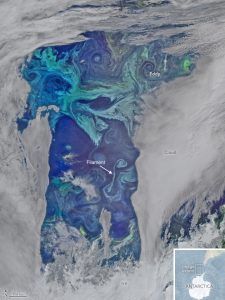
Visible Infrared Image from the Suomi satellite captures an extensive phytoplankton bloom just west of the Drake Passage, one of the most turbulent regions in the ocean. Mesoscale eddies and submesoscales filaments are noticeable on this image. © https://earthobservatory. nasa.gov.
Mesoscale and submesoscale ocean turbulence is known to impact vertical and horizontal heat transport, potentially playing a key role in the Climate system. Mesoscale eddies result from the baroclinic instability of the large-scale ocean currents. In turn, the interactions between mesoscale eddies generate submesoscale fronts and filaments associated with frontogenetic processes. Studying these dynamics and their impact (e.g. in terms of heat transport) requires data resolving a broad range of spatial and time scales. This is the focus of our group, which aims at analyzing large dataset at high-resolution, guided by geophysical fluid dynamics concepts, in order to enable new discoveries of ocean dynamics.
Research by our group focuses on:
- Mesoscale (50-500 km) and submesoscale dynamics (<50 km)
- Scale interactions in the upper ocean (from ~1 to 1,000 km)
- Horizontal and vertical heat transport associated with (sub)mesoscales
To address these topics, we use the following data:
- Remote sensing data such SWOT (Surface Water Ocean Topography) and conventional altimetry observations of sea surface height and microwave sea surface temperature (e.g. AMS-R)
- High-resolution global models (coupled and forced) ran at NASA/JPL
- In situ observations (e.g. oceangliders, instrumented marine mammals, surface drifters)

Vorticity (left panel) and inverse Richardson number (right panel) in a 1/48° ocean-forced simulation in the Kerguelen region, Southern Ocean. Siegelman (2020, JPO)
![]() Selected relevant publications:
Selected relevant publications:
- Carli, E., Siegelman, L., Morrow, R., Vergara, O. (2024). Surface Quasi Geostrophic Reconstruction of Vertical Velocities and Vertical Heat Fluxes in the Southern Ocean: Perspectives for SWOT. JGR – Oceans. http://dx.doi.org/10.1029/2024JC021216
- Klein, P., Lapeyre, G., Siegelman, L., Qiu, B., Fu, L., Torres, H., Su, Z., Menemenlis, D., & Le Gentil, S. (2019). Ocean‐Scale Interactions From Space. Earth and Space Science, 6(5), 795–817. https://doi.org/10.1029/2018EA000492
- Siegelman, L. (2020). Energetic Submesoscale Dynamics in the Ocean Interior. Journal of Physical Oceanography, 50(3), 727–749. https://doi.org/10.1175/JPO-D-19-0253.1
- Siegelman, L., Klein, P., Rivière, P., Thompson, A. F., Torres, H. S., Flexas, M., & Menemenlis, D. (2020). Enhanced upward heat transport at deep submesoscale ocean fronts. Nature Geoscience, 13(1), 50–55. https://doi.org/10.1038/s41561-019-0489-1
- Siegelman, L., Klein, P., Thompson, A. F., Torres, H. S., & Menemenlis, D. (2020). Altimetry-Based Diagnosis of Deep-Reaching Sub-Mesoscale Ocean Fronts. Fluids, 5(3), 145. https://doi.org/10.3390/fluids5030145
- Torres, H. S., Klein, P., Siegelman, L., Qiu, B., Chen, S., Ubelmann, C., Wang, J., Menemenlis, D., & Fu, L. ‐L. (2019). Diagnosing Ocean‐Wave‐Turbulence Interactions From Space. Geophysical Research Letters, 46(15), 8933–8942. https://doi.org/10.1029/2019GL083675

SWOT satellite (left panel) and vertical section of temperature sampled by Southern Elephant Seal in the Kerguelen region (right panel) from Siegelman et al. (2020, Nat. Geosci.)
